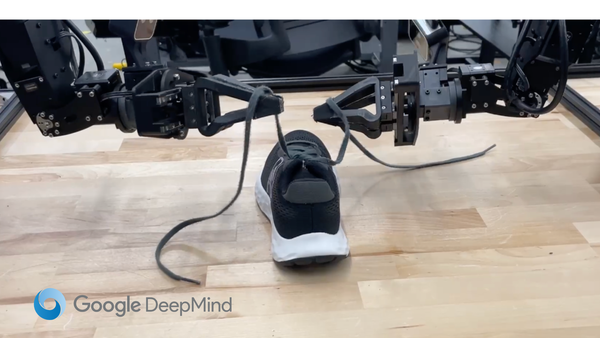Optimus Will Do Household Chores, Humanoid Robots Learn Boxing, Plus Apptronik + GXO Partnership
Explore the latest in humanoid robotics with Tesla’s Optimus for household chores, Stanford’s mimicry learning method, and the GXO-Apptronik partnership for advanced logistics robots.

The humanoid robot market gets more exciting every week. This week, we explore Elon Musk’s vision for Tesla's Optimus robot performing household chores.
We also look at Stanford's innovative training method enabling robots to learn by mimicking human actions.
Plus, we cover the promising GXO Logistics and Apptronik partnership aimed at transforming warehouse operations with advanced humanoid robotics.
Let's dive in...
Musk: Tesla’s Optimus Will Walk Your Dog and Do Household Chores
Elon Musk envisions Tesla’s humanoid robot, Optimus, as a versatile household companion capable of performing various tasks. From walking your dog to baking bread and even rocking your kids to sleep, Optimus is designed to be a fully functional and generalized humanoid robot.
Musk predicts a future where these robots become ubiquitous, with as many as 20 billion units globally.
WHAT YOU NEED TO KNOW
- Versatile Capabilities: Optimus is designed to handle numerous tasks, including household chores, childcare, cooking, and even playing the piano, making it a highly adaptable robot for everyday use.
- Widespread Adoption: Musk foresees a future where every individual has access to a personal humanoid robot, highlighting the potential for these robots to become an integral part of daily life.
- Massive Market Potential: With a projection of 20 billion humanoid robots, the market for these robots could see exponential growth, impacting various industries, from home care to manufacturing.
ELON: OPTIMUS WILL WALK YOUR DOG, BAKE YOUR BREAD, AND ROCK YOUR KIDS TO SLEEP
— Mario Nawfal (@MarioNawfal) June 20, 2024
“Optimus is intended to be a fully functional humanoid robot, capable of performing a wide range of tasks.
You can ask it to walk your dog, take care of your house, babysit the kids, teach the kids,… pic.twitter.com/U9fvYjIsE7
WHY YOU SHOULD CARE Understanding the potential of Tesla’s Optimus robot is crucial for several reasons:
- Revolutionizing Daily Life: Optimus promises to transform how we handle everyday tasks, providing convenience and efficiency in household management, which could significantly improve quality of life.
- Economic and Social Impact: The widespread adoption of humanoid robots could lead to profound changes in labor markets. Robots could take on roles traditionally held by humans, thereby reshaping economic and social structures.
- Technological Innovation: Tesla’s push towards creating a generalized humanoid robot underscores the rapid advancements in robotics and AI, setting new benchmarks for the capabilities and integration of robots in both personal and industrial contexts. This innovation could drive further developments in the field and influence future technological trends.
Source: Twitter/Cannes Lions
Humanoid Robots Learn Tennis and Boxing By Observing People
Stanford researchers have developed a new method to train humanoid robots by having them imitate human movements, enabling them to learn tasks such as playing piano, tennis, and boxing.
This approach, called "shadowing," uses a combination of AI models and direct observation to create more fluid and natural robotic motions. This innovative technique could significantly speed up training times and reduce costs for future humanoid robot development.
WHAT YOU NEED TO KNOW
- Mimicry Learning Method: Researchers trained a humanoid robot, "HumanPlus," by having it observe and mimic human movements. This method allows the robot to learn a wide range of tasks, from dexterous hand movements to complex locomotion.
- Improved Efficiency and Cost Reduction: The "shadowing" technique is more efficient than previous methods that required extensive and complex data processing. It reduces training time and associated costs, making it a promising approach for scalable humanoid robot development.
- Commercial Potential: The ability of robots to learn through mimicry can be particularly useful in industrial and home settings, where they can be trained to perform specific tasks. This adaptability could make humanoid robots more versatile and practical for various applications.
Introduce HumanPlus - Shadowing part
— Zipeng Fu (@zipengfu) June 13, 2024
Humanoids are born for using human data. We build a real-time shadowing system using a single RGB camera and a whole-body policy for cloning human motion. Examples:
- boxing🥊
- playing the piano🎹/ping pong
- tossing
- typing
Open-sourced! pic.twitter.com/DQgVDPiNnS
WHY YOU SHOULD CARE Understanding the development and potential of mimicry learning in humanoid robots is essential for several reasons:
- Technological Innovation: The new training method represents a significant advancement in robotics, offering a more natural and efficient way for robots to learn human tasks. This could lead to more intuitive and capable robotic systems.
- Economic Impact: As companies like Figure and Tesla push commercializing humanoid robots, the ability to quickly and cost-effectively train robots through mimicry could accelerate their deployment across various industries, potentially transforming the labor market.
- Enhanced Accessibility: Robots capable of learning through mimicry could improve the functionality of assistive technologies, offering better support for individuals with disabilities and enhancing their quality of life. This could open new avenues for the development and use of robotics in healthcare and personal assistance.
Source: Popular Science; Twitter
GXO and Apptronik Announce Multi-Phase R&D Partnership for Humanoid Robots
GXO Logistics, the world’s largest pure-play contract logistics provider, is partnering with Apptronik to develop and test the Apollo humanoid robot. This multi-phase R&D initiative aims to create practical applications for Apollo in warehouse environments, enhancing operational efficiency and safety.
The collaboration marks a significant step in GXO’s strategy to integrate advanced humanoid robots into its logistics operations.
WHAT YOU NEED TO KNOW
- Strategic Partnership: GXO and Apptronik are working together on a proof-of-concept program to develop Apollo, a versatile humanoid robot designed to perform various tasks in a distribution center, from transporting boxes to picking individual items.
- Advanced Capabilities: Apollo stands 5'8" tall, can carry up to 55 pounds, and operates on swappable batteries for extended use. It features linear actuators that mimic human muscles and a flexible safety zone perimeter for safe interaction with humans.
- Future Deployment: The R&D program includes lab evaluations to refine Apollo’s AI model before deploying it to a U.S. distribution center. The initiative reflects GXO’s commitment to enhancing warehouse automation and leveraging cutting-edge robotics.
WHY YOU SHOULD CARE Understanding GXO's collaboration with Apptronik is essential for several reasons:
- Innovation in Logistics: This partnership highlights the ongoing innovation in the logistics industry, where humanoid robots like Apollo can significantly reduce repetitive tasks, improve safety, and allow human workers to focus on higher-value activities.
- Technological Advancement: The development and integration of advanced AI-enabled robots demonstrate the potential for robots to handle complex tasks with precision and efficiency, setting new standards for warehouse operations.
- Market Leadership: GXO’s proactive approach to adopting and trialing new robotic technologies positions it as a leader in the warehouse automation space, influencing market trends and shaping the future of logistics. This initiative could serve as a benchmark for other companies looking to enhance their operations with humanoid robots.
Source: Globe Newswire



